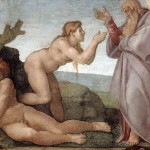I could have kicked myself. For more than ten years I’d recognized John 19:34 as the gospels climax, capstone and bloom. I’d seen how it’s allusion to the creation of Eve brought together the gospel’s theme of new creation, marriage and oneness with God. But until that moment I’d simply overlooked it’s relationship to the most well-known characteristic of John’s gospel, the new birth.
Like every Evangelical, I love the term “born again!” It perfectly describes how the Holy Spirit transforms hearts and lives. I’ve experienced it. But until then I’d never realized how this term points to an event other than conversion. I now see how John uses it as powerful metaphor for what Jesus did on the cross.
Have you ever seen the crucifixion as Jesus’ labor pains and his death as the moment of birth? That may sound odd. But its exactly what John wants us to see in Jesus’ pierced side and its flow of blood and water (John 19:34)
Apart from 1 Peter 1:22-23, the new birth is found exclusively in John’s Gospel and letters. We could say its his whole point. John summarizes his gospel this way,
These things have been written so that you may believe that Jesus is the Christ, the son of God, and that by believing you may have life in his name. (20:30-31)
How does this new life occur? Through a Divine birth of course. John spells it out for his readers four times.
(1) Born of God (1:11-13)
The nativity forms the heart of John’s introduction (1:1-18) But unlike Matthew and Luke it’s not Jesus‘. John 1:12-13 reads,
But to all who did receive him (Jesus), who believed in his name, he gave the right to become children of God, who were born, not of blood nor the will of the flesh nor the will of man, but of God.
The significance of the believers birth is only underscored by its position within the prologue’s structure. These opening eighteen verses form a chiasm, an ancient rhetorical pattern which rotates around and points to a central core. And John 1:12-13 is that core. The new birth is John’s thesis statement, a parallel to his summary on the other end of the book (20:30-31). The gospel results in a spiritual nativity. Reception of Jesus leads to a birth from God.
(2) Born Again (3:3-6)
The birth metaphor next appears in Jesus’ conversation with the aged Pharisee, Nicodimus. Jesus tells him outright, “no one can see the kingdom of God unless he is born again.” Confused, Nicodimus asks, “How can a man be born when he is old? Can he enter his mother’s womb a second time?” Jesus clarifies his statement by rephrasing it. “Unless a man be born of water and the spirit he cannot enter the kingdom of God.”
The rephrasing here is important. Nicodimus has stumbled over Jesus’ use of the word again, the Greek word anothen. Anothen can mean a second time, but unlike the English translation, it can also mean ‘from above.’ The new birth of which Jesus speaks is not a second physical birth but an entirely new birth from God, a birth ‘of water and Spirit” or more accurately “water which is the Spirit.” Jesus’ here echos the words of the prologue. This birth is not from any human being but is entirely Divine in origin.
(3) New Sight (9:1-10)
The birth imagery is again found in the opened eyes of the blind man in John 9. Note how John over and over again tells us that the man’s blindness was from birth (9:1-2, 19-20, 32-33). Through the emphasis, John depicts Jesus’ miraculous gift of sight as the man’s birth to new life.
(4) Labor Pains (16:20-22)
The last clear use of the birth metaphor is found in Jesus’ upper room discourse. Here, Jesus compares the sorrow of the disciples to a woman in labor.
Truly, truly, I say to you, you will weep and lament, but the world will rejoice. You will be sorrowful, but your sorrow will turn to joy. When a woman is giving birth, she has sorrow because her hour has come, but when she has delivered the baby, she no longer remembers the anguish, for joy that a human being has been born into the world. So also you have sorrow now, but I will see you again, and your hearts will rejoice, and no one will turn your joy from you.
In the analogy, the disciples are mother’s in labor and it’s Jesus, in his death and resurrection, who is being born.
But the analogy also implicitly and more accurately points to Jesus as the one giving birth. The disciples are sorrowful but they don’t experience anything close to the physical pain of crucifixion. And of course their sorrow doesn’t produce the resurrection in the same way a mother’s pain produces a child or the way Jesus’ physical suffering brings about the believers new birth (1:12-13). Jesus’ use of the word “hour” for a woman’s labor pains (16:21) also reminds the reader of Jesus’ climatic hour which he has used as a reference to the cross so many times before (John 2:4, 7:6, 8, 30, 8:20, 12:23, 27, 13:1, 17:1).
Given the repeated emphasis on a birth from God, it seems highly likely that John intended his readers to see the further implications of this analogy. The cross is Jesus hour, his labor for our birth. A birth which quite fittingly comes from the side of God.
If we were to look for a birth in John’s depiction of the crucifixion we would find no better illustration than the flow of blood and water from the pierced side of Christ and its allusion to the creation of Eve in Genesis 2:21-24.
To be continued…
















